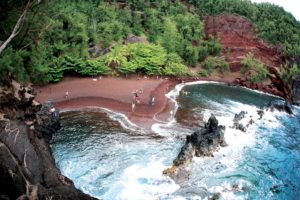Even though Maui has a dormant volcano that will likely erupt again, Maui’s most active eruption today has nothing to do with lava.
Rather it’s a forceful explosion of seawater that erupts on a regular basis—often as frequently as every few minutes when the surf and wind are both up. Set on the island’s northwestern coast, Nakalele Blowhole is a natural geyser where seawater trapped in an underwater lava tube is searching for a way to escape.
Since it can’t go back the way it came in—there’s too much pressure from the waves—the only outlet is a tire-sized hole in the jagged, jet-black lava rock, where a column of water is powerfully jettisoned up to 100 feet in the air.
Behold the Beauty, Beware the Dangers
When viewing the Nakalele Blowhole in morning, there is often a rainbow that forms in the mist if you keep the sun toward your back, and whales are often seen leaping in the distance from December all the way through May. Despite the geyser’s beauty, however, it’s important to remember the blowhole is dangerous and accidents frequently happen—particularly when people stand too close and slip and fall on the rocks. In a couple of rare but terrifying instances, the blowhole has sucked people into the hole who were literally standing right over it, and visitors have even drowned at the spot after disappearing in the hole.
Dry Rocks Keep You Safe
As a rule of thumb, the safest way to view Nakalele Blowhole is to simply stay on dry rocks. Admire and appreciate the blowhole from a distance, and avoid venturing dangerously close, even on the smallest of days. Nakalele Blowhole, while rather consistent, is dependent on both tide and swell, and days with no wind and little north swell can render the blowhole inactive.
How to Find Nakalele Blowhole
To find the trail to Nakalele Blowhole, drive north from Kapalua for approximately 8 miles, and park when you see the mileage marker that says 38.5. There are numerous trails that criss-cross the landscape, and they all lead down to the blowhole, but the trail from mile marker 38.5 is not only the safest route but also offers a look at the famous heart-shaped hole in the rock.
Maui’s Heart Shaped Rock
When you reach the bottom of the scree slope trail and the blowhole is off to your left, turn around and look behind you—placing the blowhole at your back. Here you’ll see a heart-shaped hole that’s formed in the middle of the rocks, and frames a coastal, tropical scene of mountains, seashore, and waves. The hole in the rock is now an Instagram darling—more popular than even the blowhole—though it can never compete with the time-stopping fury that Nakalele can bring; a thunderous, vertical, rainbow-clad marvel, with a view stretching out to the Molokaʻi cliffs, the blue Pacific, and beyond.







